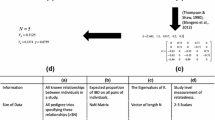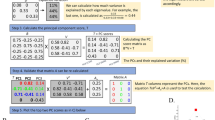Abstract
Martin and Eaves (Heredity 38(1):79–95, 1977) proposed a multivariate model for twin and family data in order to investigate potential differences in the genetic and environmental architecture of multivariate phenotypes. The general form of the model is the independent pathway model, which differentiates between genetic and environmental influences at the item level, and therefore permits the decomposition to differ across items. A restricted version is the common pathway model, where the decomposition takes place at the factor level. The paper has spurred numerous studies, and evidence for differences in genetic and environmental architecture has been established for personality and several other psychiatric phenotypes by showing a better fit of the independent pathway model compared to the common pathway model. We show that genome-wide association studies (GWAS) that use an aggregate score computed from multiple questionnaire items as a univariate phenotype implicitly assume a similar structure as the common pathway model. It has been shown that in case of a differential genetic and environmental architecture, multivariate GWAS methods can outperform the univariate GWAS approach. However, current multivariate methods rely on the assumptions of phenotypic and genetic homogeneity, that is, item responses are assumed to have the same means and covariances, and genetic effects are assumed to be the same for all subjects. We describe a distance-based regression technique that is designed to account for subgroups in the population, and that therefore can account for differential genetic effects. A first evaluation with simulated data shows a substantial increase of power compared to univariate GWAS.


Similar content being viewed by others
Notes
Collinearity means that the two loading matrices are multiples of each other, and therefore impose the same pattern of interrelations between items.
COSA is freely available at http://statweb.stanford.edu/~jhf/COSA.html.
We are currently testing a parallelized implementation of MDMR, which will be available on request.
References
Anderson MJ (2001) A new method for non-parametric multivariate analysis of variance. Austral Ecol 26(1):32–46
Draisma HH, Reijmers TH, Bobeldijk-Pastorova I, Meulman JJ, Estourgie-Van Burk GF, Bartels M, Ramaker R, van der Greef J, Boomsma DI, Hankemeier T (2008) Similarities and differences in lipidomics profiles among healthy monozygotic twin pairs. Omics 12(1):17–31
Eaves LJ, Martin NG, Eysenck SB (1977) An application of the analysis of covariance structures to the psychogenetical study of impulsiveness. Br J Math Stat Psychol 30(2):185–197
Friedman JH, Meulman JJ (2004) Clustering objects on subsets of attributes (with discussion). J R Stat Soc B 66(4):815–849
Gower J (1966) Some distance properties of latent root and vector methods used in multivariate analysis. Biometrika 53(3):325–338
Heath AC, Martin NG (1990) Psychoticism as a dimension of personality: a multivariate genetic test of Eysenck and Eysenck’s psychoticism construct. J Pers Soc Psychol 58(1):111
Iervolino AC, Rijsdijk FV, Cherkas L, Fullana MA, Mataix-Cols D (2011) A multivariate twin study of obsessive-compulsive symptom dimensions. Arch Gen Psychiatry 68(6):637
Kendler KS, Heath AC, Martin NG, Eaves LJ (1987) Symptoms of anxiety and symptoms of depression: same genes, different environments? Arch Gen Psychiatry 44(5):451
Kendler KS, Aggen SH, Czajkowski N, Roysamb E, Tambs K, Torgersen S, Reichborn-Kjennerud T (2008) The structure of genetic and environmental risk factors for DSM-IV personality disorders: a multivariate twin study. Arch Gen Psychiatry 65(12):1438
Klonsky ED, Olino TM (2008) Identifying clinically distinct subgroups of self-injurers among young adults: a latent class analysis. J Consult Clin Psychol 76(1):22
Lamers F, Vogelzangs N, Merikangas KR, de Jonge P, Beekman ATF, Penninx BWJH (2012) Evidence for a differential role of HPA-axis function, inflammation and metabolic syndrome in melancholic versus atypical depression. Mol psychiatry. doi:10.1038/mp.2012.144
Manchia M, Cullis J, Turecki G, Rouleau GA, Uher R et al (2013) The impact of phenotypic and genetic heterogeneity on results of genome wide association studies of complex diseases. PLoS One 8(10):e76295. doi:10.1371/journal.pone.0076295
Martin NG, Eaves LJ (1977) The genetical analysis of covariance structure. Heredity 38(1):79–95
McArdle BH, Anderson MJ (2001) Fitting multivariate models to community data: a comment on distance-based redundancy analysis. Ecology 82(1):290–297
McArdle JJ, Goldsmith HH (1990) Alternative common factor models for multivariate biometric analyses. Behav Genet 20(5):569–608
O’Reilly PF, Hoggart CJ, Pomyen Y, Calboli FC, Elliott P, Jarvelin MR, Coin LJ (2012) MultiPhen: joint model of multiple phenotypes can increase discovery in GWAS. PLoS One 7(5):e34861
Ronald A, Happe F, Bolton P, Butcher LM, Price TS, Wheelwright S, Plomin R (2006) Genetic heterogeneity between the three components of the autism spectrum: a twin study. J Am Acad Child Adolesc Psychiatry 45(6):691–699
Schork NJ, Zapala MA (2012) Statistical properties of multivariate distance matrix regression for high-dimensional data analysis. Front Genet 3:190
van der Sluis S, Posthuma D, Dolan CV (2013) TATES: efficient multivariate genotype-phenotype analysis for genome-wide association studies. PLoS Genet 9(1):e1003235
Wessel J, Zapala MA, Schork NJ (2007) Accommodating pathway information in expression quantitative trait locus analysis. Genomics 90(1):132–142
Witten DM, Tibshirani R (2010) A framework for feature selection in clustering. J Am Stat Assoc 105(490):713–726
York TP, Eaves LJ, van den Oord EJ (2006) Multivariate adaptive regression splines: a powerful method for detecting disease–risk relationship differences among subgroups. Stat Med 25(8):1355–1367
Zapala MA, Schork NJ (2006) Multivariate regression analysis of distance matrices for testing associations between gene expression patterns and related variables. Proc Natl Acad Sci 103(51):19430–19435
Author information
Authors and Affiliations
Corresponding author
Rights and permissions
About this article
Cite this article
Lubke, G., McArtor, D. Multivariate Genetic Analyses in Heterogeneous Populations. Behav Genet 44, 232–239 (2014). https://doi.org/10.1007/s10519-013-9631-9
Received:
Accepted:
Published:
Issue Date:
DOI: https://doi.org/10.1007/s10519-013-9631-9




